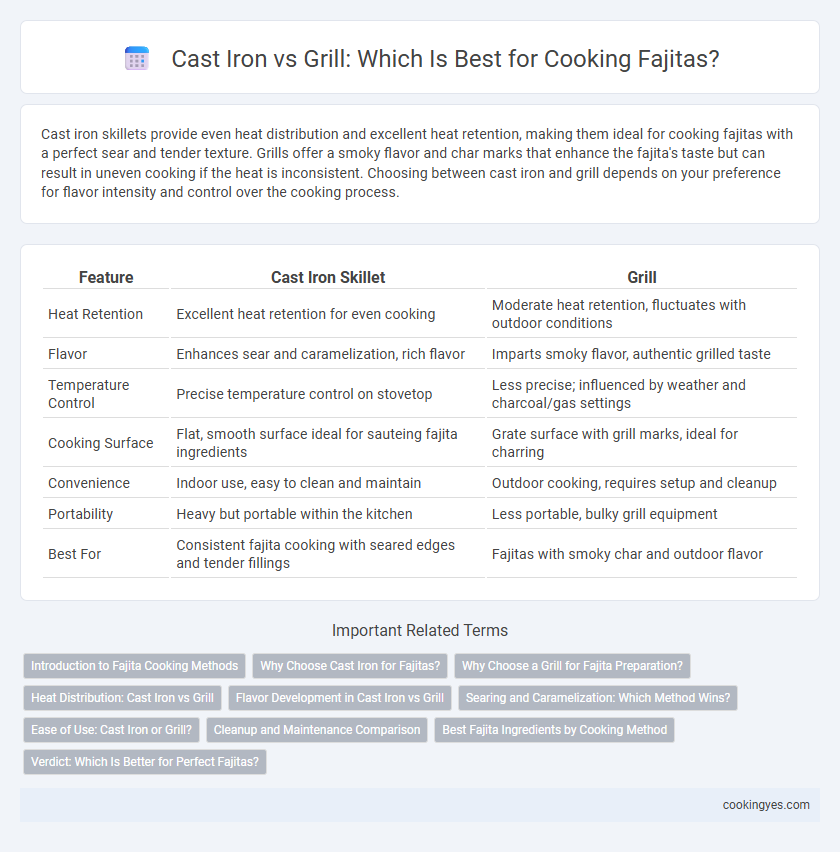Cast iron skillets provide even heat distribution and excellent heat retention, making them ideal for cooking fajitas with a perfect sear and tender texture. Grills offer a smoky flavor and char marks that enhance the fajita's taste but can result in uneven cooking if the heat is inconsistent. Choosing between cast iron and grill depends on your preference for flavor intensity and control over the cooking process.
Table of Comparison
| Feature | Cast Iron Skillet | Grill |
|---|---|---|
| Heat Retention | Excellent heat retention for even cooking | Moderate heat retention, fluctuates with outdoor conditions |
| Flavor | Enhances sear and caramelization, rich flavor | Imparts smoky flavor, authentic grilled taste |
| Temperature Control | Precise temperature control on stovetop | Less precise; influenced by weather and charcoal/gas settings |
| Cooking Surface | Flat, smooth surface ideal for sauteing fajita ingredients | Grate surface with grill marks, ideal for charring |
| Convenience | Indoor use, easy to clean and maintain | Outdoor cooking, requires setup and cleanup |
| Portability | Heavy but portable within the kitchen | Less portable, bulky grill equipment |
| Best For | Consistent fajita cooking with seared edges and tender fillings | Fajitas with smoky char and outdoor flavor |
Introduction to Fajita Cooking Methods
Fajita cooking methods primarily involve either cast iron skillets or outdoor grills, each offering distinct advantages for achieving authentic flavors. Cast iron skillets provide even heat distribution and excellent heat retention, ideal for searing marinated strips of beef, chicken, or vegetables to develop a rich, caramelized crust. Outdoor grills impart a smoky char and allow excess fat to drip away, enhancing the fajita's signature grilled aroma and texture.
Why Choose Cast Iron for Fajitas?
Cast iron skillets provide superior heat retention and even cooking, essential for achieving the perfect sear on fajitas. Their heavy construction ensures consistent high temperatures, locking in the juices and flavors of marinated meats and vegetables. Unlike grills, cast iron allows precise temperature control indoors, making it ideal for year-round fajita preparation.
Why Choose a Grill for Fajita Preparation?
Grills provide a high, direct heat ideal for caramelizing fajita meat and vegetables, enhancing their smoky flavor and creating authentic grill marks. The open cooking surface allows fat to drip away, resulting in a healthier, less greasy dish compared to cast iron skillets. Grilling also imparts a distinctive char that is difficult to replicate on cast iron, making it the preferred method for traditional fajita preparation.
Heat Distribution: Cast Iron vs Grill
Cast iron skillets provide superior heat retention and even heat distribution, essential for achieving the perfect sear on fajita ingredients, ensuring consistent cooking throughout. Grills produce direct, high heat with variable temperature zones, which can create authentic char marks but may result in uneven cooking if not monitored closely. For fajita cooking, cast iron offers controlled, uniform heat ideal for tenderizing meats and caramelizing vegetables, while grills deliver smoky flavors with a more rustic heat pattern.
Flavor Development in Cast Iron vs Grill
Cast iron skillets excel at developing deep, caramelized flavors due to their ability to retain and evenly distribute high heat, creating a rich Maillard reaction on fajita meat and vegetables. Grills impart a distinct smoky char and grill marks, enhancing flavor complexity through direct exposure to open flames and smoke. While grills add a unique smoky aroma, cast iron ensures intense searing and crust formation, intensifying the savory taste profile in fajitas.
Searing and Caramelization: Which Method Wins?
Cast iron skillets excel at searing and caramelization for fajitas due to their ability to retain and evenly distribute high heat, creating a perfect crust on the meat and vegetables. Grills provide distinct char marks and smoky flavor, but often lack consistent surface contact, which can hinder thorough caramelization. For maximum searing and caramelization, cast iron is the preferred method, ensuring tender, flavorful fajitas with a rich browned exterior.
Ease of Use: Cast Iron or Grill?
Cast iron skillets offer superior ease of use for cooking fajitas due to their consistent heat retention and ability to evenly sear vegetables and meats indoors without the need for temperature adjustments. Grills, while imparting smoky flavor, require constant monitoring of heat zones and can be less convenient for controlled cooking, especially in unpredictable weather conditions. The cast iron skillet's versatility and temperature control make it the preferred choice for home cooks seeking simplicity and reliable results.
Cleanup and Maintenance Comparison
Cast iron skillets require seasoning and thorough drying after each use to prevent rust, making cleanup more meticulous but enhancing non-stick properties over time. Grills generally need thorough scrubbing to remove charred food and grease buildup, often involving wire brushes and grill cleaners, which can be time-consuming but are less prone to rust if properly maintained. Both methods demand regular care, but cast iron offers long-term durability with proper seasoning, while grills require more frequent surface cleaning to maintain optimal performance.
Best Fajita Ingredients by Cooking Method
Cast iron skillets retain and evenly distribute heat, making them ideal for cooking fajitas with ingredients like marinated beef, chicken, and bell peppers, which benefit from a seared crust and caramelization. Grilling fajitas infuses a smoky flavor that enhances proteins such as skirt steak and fresh vegetables like onions and poblano peppers, capturing the essence of traditional Tex-Mex cuisine. For the best fajita experience, use cast iron for tender, juicy meats and a rich sear, while grilling highlights bold, charred flavors and smoky aroma.
Verdict: Which Is Better for Perfect Fajitas?
Cast iron skillets provide even heat distribution and excellent heat retention, which creates a perfect sear and caramelization on fajita meat and vegetables. Grills impart a smoky flavor and char marks that enhance the overall taste and authenticity of fajitas. For the perfect fajitas, cast iron is ideal for controlled cooking indoors, while grilling excels for outdoor, smoky-flavored fajitas.
Cast iron vs Grill for fajita cooking Infographic

 cookingyes.com
cookingyes.com